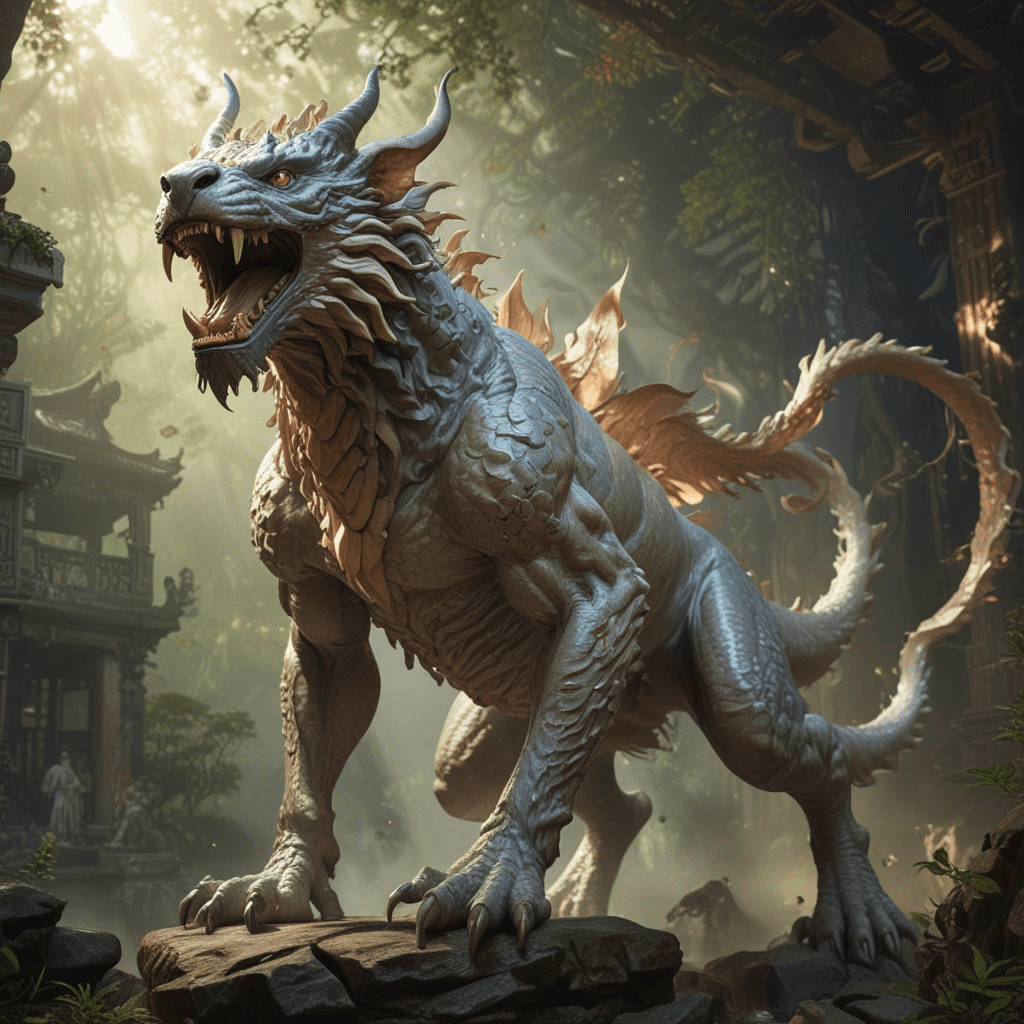The Tale of the Nue: The Chimera Creature in Japanese Mythology
Introduction
In the realm of Japanese folklore, the Nue emerges as a captivating chimera, a mystical creature composed of a myriad of animal parts. Its enigmatic presence has woven a rich tapestry of legends and tales, entrenching it deeply within the cultural consciousness.
Origins of the Nue
The Nue's genesis remains shrouded in mystery, with various theories attempting to unravel its origins. Some accounts trace its lineage back to ancient Chinese mythology, while others speculate that it emerged from the depths of Japanese folklore. Regardless of its true origins, the Nue's existence has captivated imaginations for centuries.
Physical Appearance
The Nue's physical form is a grotesque amalgamation of animal features. Its head resembles that of a monkey's, possessing sharp fangs and unnaturally glowing red eyes. Atop its head, a pair of horns resembles those of an ox. Its body is covered in thick, dark fur, giving it the appearance of a bear. Extending from its back, a pair of tiger-like wings allow it to soar through the air with ease. Completing its bizarre form is a long, serpentine tail, its scales shimmering with an eerie luminescence.
Habitat and Behavior
The Nue's natural habitat is said to be in the mountainous regions of Japan. It prefers to dwell in secluded caves or dense forests, away from the bustling of human activity. Its nocturnal nature makes it primarily active during the night, where it hunts for prey under the cover of darkness. Despite its formidable appearance, the Nue is considered a solitary creature, rarely interacting with its own kind.
The Nue and the Emperor
One of the most famous tales involving the Nue revolves around Emperor Konoe. In the 12th century, the emperor fell mysteriously ill, plagued by nightly nightmares and a sense of impending doom. Court officials sought the counsel of the renowned阴阳师Abe no Seimei, who identified the Nue as the source of the emperor's affliction. Seimei dispatched Minamoto no Yorimasa to confront the creature, who succeeded in slaying the Nue with his legendary bow. The emperor's health was restored, and the Nue's reign of terror came to an end.
The Nue's Role in Japanese Culture
The Nue holds a significant place in Japanese culture, serving as an embodiment of fear, misfortune, and the unknown. Its presence in art, literature, and folklore reflects its profound impact on the Japanese psyche. Depictions of the Nue often adorn temples, shrines, and traditional paintings, serving as a cautionary tale against evil and malevolence.
Legends and Folklore
Numerous legends and folktales surround the Nue, each contributing to its enigmatic aura. In one tale, a group of hunters encounters the Nue deep within a forest. Its piercing gaze and eerie cry send shivers down their spines as they flee in terror. Another legend tells of a village plagued by a mysterious illness. As the villagers desperately search for a cure, a wise old woman reveals that the Nue is responsible for their suffering.
Modern Interpretations
In the contemporary era, the Nue continues to captivate the imaginations of creatives. Modern interpretations of the creature often explore its symbolism and significance in a changing world. In anime and manga, the Nue appears as a formidable adversary, embodying the darkness that lurks within the human heart. Contemporary artists have also embraced the Nue's grotesque beauty, using its form as inspiration for sculptures and paintings.
Symbolism and Significance
The Nue serves as a multifaceted symbol within Japanese culture. Its monstrous appearance represents the fears and anxieties that haunt the human psyche. It embodies the chaos and disruption that can arise from unchecked desires and negative emotions. At the same time, the Nue's slaying by Minamoto no Yorimasa symbolizes the triumph of good over evil, offering a glimmer of hope in the face of adversity.
Conclusion
The Tale of the Nue is an enduring testament to the power of mythology and its ability to shape human imagination. From its ancient origins to its modern interpretations, the Nue remains a captivating symbol of fear, mystery, and cultural significance. Its presence in Japanese folklore, art, and literature continues to inspire and intrigue, ensuring its legacy as a timeless and enigmatic creature in the annals of Japanese mythology.
FAQs
1. What is the Nue's physical appearance?
The Nue is a chimera creature with the head of a monkey, the body of a bear, the wings of a tiger, and the tail of a serpent. It has glowing red eyes, sharp fangs, and horns resembling those of an ox.
2. Where does the Nue live and what does it do?
The Nue dwells in mountainous regions and dense forests, primarily active at night. It hunts for prey under the cover of darkness and is considered a solitary creature.
3. What is the Nue's role in Japanese culture?
The Nue embodies fear, misfortune, and the unknown in Japanese culture. It is often depicted in art and literature as a cautionary tale against evil and malevolence.
4. What is the symbolism of the Nue?
The Nue represents the fears and anxieties that haunt the human psyche, as well as the chaos and disruption that can arise from unchecked desires and negative emotions. It also symbolizes the triumph of good over evil.



